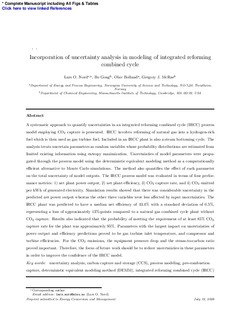| dc.contributor.author | Nord, Lars Olof | |
| dc.contributor.author | Gong, Bo | |
| dc.contributor.author | Bolland, Olav | |
| dc.contributor.author | McRae, Gregory J. | |
| dc.date.accessioned | 2016-10-12T08:15:39Z | |
| dc.date.accessioned | 2016-10-17T08:25:25Z | |
| dc.date.available | 2016-10-12T08:15:39Z | |
| dc.date.available | 2016-10-17T08:25:25Z | |
| dc.date.issued | 2010 | |
| dc.identifier.citation | Energy Conversion and Management 2010, 51(10):2068-2078 | nb_NO |
| dc.identifier.issn | 0196-8904 | |
| dc.identifier.uri | http://hdl.handle.net/11250/2415460 | |
| dc.description.abstract | A systematic approach to quantify uncertainties in an integrated reforming combined cycle (IRCC) process model employing CO2 capture is presented. IRCC involves reforming of natural gas into a hydrogen-rich fuel which is then used as gas turbine fuel. Included in an IRCC plant is also a steam bottoming cycle. The analysis treats uncertain parameters as random variables whose probability distributions are estimated from limited existing information using entropy maximization. Uncertainties of model parameters were propagated through the process model using the deterministic equivalent modeling method as a computationally efficient alternative to Monte Carlo simulations. The method also quantifies the effect of each parameter on the total uncertainty of model outputs. The IRCC process model was evaluated in terms of four performance metrics: (1) net plant power output, (2) net plant efficiency, (3) CO2 capture rate, and (4) CO2 emitted per kWh of generated electricity. Simulation results showed that there was considerable uncertainty in the predicted net power output whereas the other three variables were less affected by input uncertainties. The IRCC plant was predicted to have a median net plant efficiency of 43.4% with a standard deviation of 0.5%, representing a loss of approximately 13%-points compared to a natural gas combined cycle plant without CO2 capture. Results also indicated that the probability of meeting the requirement of at least 85% CO2 capture rate for the plant was approximately 95%. Parameters with the largest impact on uncertainties of power output and efficiency predictions proved to be gas turbine inlet temperature, and compressor and turbine efficiencies. For the CO2 emissions, the equipment pressure drop and the steam-to-carbon ratio proved important. Therefore, the focus of future work should be to reduce uncertainties in these parameters in order to improve the confidence of the IRCC model. | nb_NO |
| dc.language.iso | eng | nb_NO |
| dc.publisher | Elsevier | nb_NO |
| dc.rights | Navngivelse-Ikkekommersiell-IngenBearbeidelse 3.0 Norge | * |
| dc.rights.uri | http://creativecommons.org/licenses/by-nc-nd/3.0/no/ | * |
| dc.title | Incorporation of uncertainty analysis in modeling of integrated reforming combined cycle | nb_NO |
| dc.type | Journal article | nb_NO |
| dc.type | Peer reviewed | nb_NO |
| dc.date.updated | 2016-10-12T08:15:39Z | |
| dc.source.pagenumber | 2068-2078 | nb_NO |
| dc.source.volume | 51 | nb_NO |
| dc.source.journal | Energy Conversion and Management | nb_NO |
| dc.source.issue | 10 | nb_NO |
| dc.identifier.doi | 10.1016/j.enconman.2010.02.040 | |
| dc.identifier.cristin | 349410 | |
| dc.description.localcode | This is the authors' accepted and refereed manuscript to the article. Author's post-print is licensed under a Creative Commons Attribution Non-Commercial No Derivatives License. | nb_NO |

